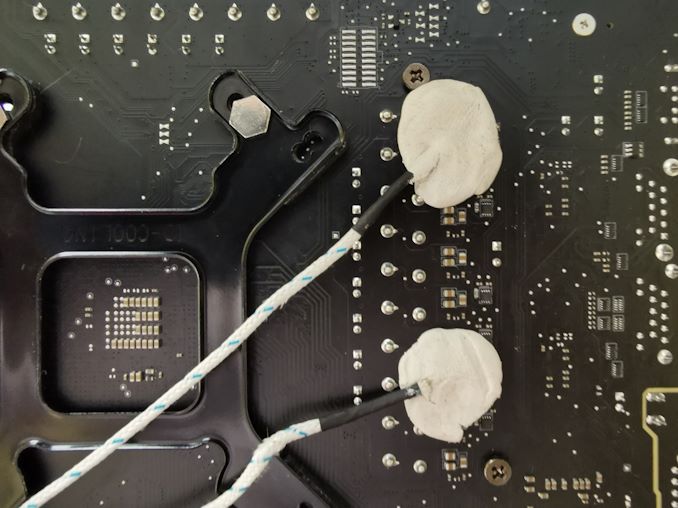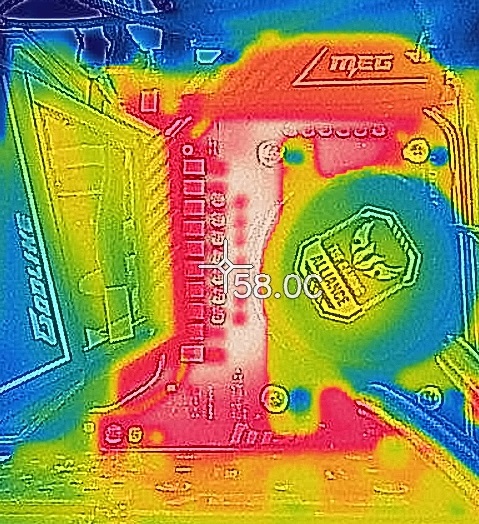The MSI MEG X570 Godlike Motherboard Review: Thor's Flagship
by Gavin Bonshor on August 28, 2019 12:00 PM EST- Posted in
- Motherboards
- AMD
- MSI
- 10G Ethernet
- Ryzen
- PCIe 4.0
- Ryzen 3000
- X570
- X570 Godlike
- MEG
Power Delivery Thermal Analysis
One of the most requested elements of our motherboard reviews revolves around the power delivery and its componentry. Aside from the quality of the components and its capability for overclocking to push out higher clock speeds which in turn improves performance, is the thermal capability of the cooling solutions implemented by manufacturers. While almost always fine for users running processors at default settings, the cooling capability of the VRMs isn't something that users should worry too much about, but for those looking to squeeze out extra performance from the CPU via overclocking, this puts extra pressure on the power delivery and in turn, generates extra heat. This is why more premium models often include heatsinks on its models with better cooling designs, heftier chunks of metal, and in some cases, even with water blocks such as the ASUS ROG Crosshair VIII Formula.

Two K-Type Thermal Probes attached to the rear of the power delivery on the MSI MEG X570 Godlike
Testing Methodology
Out method of testing out if the power delivery and its heatsink are effective at dissipating heat, is by running an intensely heavy CPU workload for a prolonged method of time. We apply an overclock which is deemed safe and at the maximum that the silicon on our AMD Ryzen 7 3700X processor allows. We then run the Prime95 with AVX2 enabled under a torture test for an hour at the maximum stable overclock we can which puts insane pressure on the processor. We collect our data via three different methods which include the following:
- Taking a thermal image from a birds-eye view after an hour with a Flir Pro thermal imaging camera
- Securing two probes on to the rear of the PCB, right underneath CPU VCore section of the power delivery for better parity in case a probe reports a faulty reading
- Taking a reading of the VRM temperature from the sensor reading within the HWInfo monitoring application
The reason for using three different methods is that some sensors can read inaccurate temperatures, which can give very erratic results for users looking to gauge whether an overclock is too much pressure for the power delivery handle. With using a probe on the rear, it can also show the efficiency of the power stages and heatsinks as a wide margin between the probe and sensor temperature can show that the heatsink is dissipating heat and that the design is working, or that the internal sensor is massively wrong. To ensure our probe was accurate prior to testing, I personally binned 10 and selected the most accurate (within 1c of the actual temperature) for better parity in our testing.
For thermal image, we use a Flir One camera as it gives a good indication of where the heat is generated around the socket area, as some designs use different configurations and an evenly spread power delivery with good components will usually generate less heat. Manufacturers who use inefficient heatsinks and cheap out on power delivery components should run hotter than those who have invested. Of course, a $700 flagship motherboard is likely to outperform a cheaper $100 model under the same testing conditions, but it is still worth testing to see which vendors are doing things correctly.
Thermal Analysis Results

We measured 58°C on PCB between the CPU socket and power delivery
The MSI MEG X570 Godlike is running a 14-phase design for the CPU VCore section. This includes an International Rectifier IR35201 running in a 7+1 configuration with seven IR3599 doublers on the rear of the PCB; the SoC section is running four phases off a single IR3599 which splits the signal into four. As far as designs go, this is MSI's best AMD power delivery that I can recall seeing, although I still find it a little odd that the SoC section is split into four, but through one IR3599 doubler in quad mode. Perhaps this will yield some benefits and gains for extreme overclockers, but it's not an issue for general users to be concerned about. The heatsink is very similar to the MSI MEG X570 Ace and uses the same design. The power delivery heatsinks are interconnected by a heat pipe which stretches around the left side of the memory slots and down into the actively cooled X570 chipset heatsink.
As we get more results, we will endeavour to update this chart when more models have been tested
Note - The ASRock B450 Gaming ITX-ac model crashed instantly every time the small FFT torture test within Prime95 was initiated. At anything on the CPU VCore above 1.35 V would result in instant instability. The Ryzen Master auto-overclocking function failed every time it tried to dial in settings, but it does however operate absolutely fine at stock, and with Precision Boost Overdrive enabled. Either the firmware is the issue, or the board just isn't capable of overclocking the Ryzen 3700X with extreme workloads with what is considered a stable overclock on the X570 chipset. We will re-test this in the future.
The power delivery on the MSI MEG X570 Godlike actually runs slightly cooler in our testing which can be explained by having a slightly better 14+4 power delivery versus the 12+2 design on the MSI MEG X570 Ace. More phases usually generate less heat overall as each phase is active for a shorter period of time, which does show in our testing. We ran our AMD Ryzen 7 3700X testbed sample at 4.1 GHz with a CPU VCore of 1.45 V which is consistent with other models we have tested to try and generate as much heat as possible. The power delivery probe output reading was 59°C after an hour of testing, while the VRM temperature sensor gave us a reading of 61°C. The MSI MEG X570 Godlike does well under our testing method and there should be no issues when overclocking the current Ryzen 3000 processors, as we found that we hit CPU thermal limitations before anything else.











116 Comments
View All Comments
StrangerGuy - Friday, August 30, 2019 - link
Totally agreed, especially in this age where Youtubers have pushed the hardware e-peen waving and elitism all the way up to the high heavens.I'm using a 8700K. but I happily game on a Ryzen 1600 that's $80 used from Aliexpress with a new $65 B450 mobo if I had to; it's bizarre to see people buying into the overpriced marketing kool-aid while simultaneously whining about how expensive the hobby is.
RamarC - Thursday, August 29, 2019 - link
all i can say is "JeeBuz!"WaltC - Thursday, August 29, 2019 - link
I wanted to add my experience with my last MSI mboard that used the ALC1220 & the Nahimic 3.x software--when I got into this x570 Aorus Master and cranked up the ALC1220 & the ESS Sabre DAC, with headphone amp, all hardware, I couldn't believe how much the sound quality improved! Gawd, it was like night and day--same headphones! It was difficult to believe that @ $700 MSI went with the exact same sound hardware and software processing they put in their $190 Ryzen1 mboards--like the Gaming Pro Carbon! Remarkable! So glad I went with Aorus this time. This x570 Master is a keeper. Believe me--I have nothing against MSI--and if the Master was a poor board I'd say so....! No problem. Right now it is shaping up to be one of the best boards I've ever owned--if not the best. And for $700 I could buy two of them. Remarkable.Techie2 - Thursday, August 29, 2019 - link
What a stupid name for a mobo and an absurd price tag. Only a fool would buy this mobo.twtech - Thursday, August 29, 2019 - link
This one is definitely representative of the "Walmart kid's toy for 7-year-olds" styling that seems to have taken over the motherboard market in recent years.Not only does it have lots of non-functional, flimsy-looking plastic, it even has a cheap mirror on it - why?
PeachNCream - Friday, August 30, 2019 - link
The gaming set consists largely of tweens and man children so dinky plastic covers and a vanity mirror would very much appeal to those juvenile-minded sorts. Alternatively, MSI might be trolling them by giving them a mirror in which to look with shame upon themselves as they use a $700 motherboard to play video games from their parents' house as opposed to getting a job as something other than a part time Uber driver so they can live on their own.Korguz - Friday, August 30, 2019 - link
too bad it isnt a mirror.. but an lcd screen of sorts ?PeachNCream - Saturday, August 31, 2019 - link
You're not really into that whole reading the article thing are you?Oxford Guy - Thursday, August 29, 2019 - link
A god-like 40mm fan!PeachNCream - Friday, August 30, 2019 - link
Maybe if MSI covered the chipset in something other than stupid, angular, RGB-festooned plastic like maybe a decent sized heat sink, there would be no need for a half shrouded, dead-in-11-months little fan. But if they did that, where would they plaster the cartoon dragon?